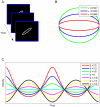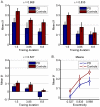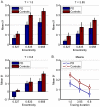Altered perceptual sensitivity to kinematic invariants in Parkinson's disease
- PMID: 22363430
- PMCID: PMC3281839
- DOI: 10.1371/journal.pone.0030369
Altered perceptual sensitivity to kinematic invariants in Parkinson's disease
Abstract
Ample evidence exists for coupling between action and perception in neurologically healthy individuals, yet the precise nature of the internal representations shared between these domains remains unclear. One experimentally derived view is that the invariant properties and constraints characterizing movement generation are also manifested during motion perception. One prominent motor invariant is the "two-third power law," describing the strong relation between the kinematics of motion and the geometrical features of the path followed by the hand during planar drawing movements. The two-thirds power law not only characterizes various movement generation tasks but also seems to constrain visual perception of motion. The present study aimed to assess whether motor invariants, such as the two thirds power law also constrain motion perception in patients with Parkinson's disease (PD). Patients with PD and age-matched controls were asked to observe the movement of a light spot rotating on an elliptical path and to modify its velocity until it appeared to move most uniformly. As in previous reports controls tended to choose those movements close to obeying the two-thirds power law as most uniform. Patients with PD displayed a more variable behavior, choosing on average, movements closer but not equal to a constant velocity. Our results thus demonstrate impairments in how the two-thirds power law constrains motion perception in patients with PD, where this relationship between velocity and curvature appears to be preserved but scaled down. Recent hypotheses on the role of the basal ganglia in motor timing may explain these irregularities. Alternatively, these impairments in perception of movement may reflect similar deficits in motor production.
Conflict of interest statement
Figures




Similar articles
-
Cathodal transcranial direct current stimulation can stabilize perception of movement: Evidence from the two-thirds power law illusion.Neurosci Lett. 2015 Nov 16;609:87-91. doi: 10.1016/j.neulet.2015.10.013. Epub 2015 Oct 14. Neurosci Lett. 2015. PMID: 26463671
-
On the similarities between the perception and production of elliptical trajectories.Exp Brain Res. 2006 Jul;172(4):533-55. doi: 10.1007/s00221-006-0355-4. Epub 2006 Feb 25. Exp Brain Res. 2006. PMID: 16501963
-
Neural representations of kinematic laws of motion: evidence for action-perception coupling.Proc Natl Acad Sci U S A. 2007 Dec 18;104(51):20582-7. doi: 10.1073/pnas.0710033104. Epub 2007 Dec 13. Proc Natl Acad Sci U S A. 2007. PMID: 18079289 Free PMC article.
-
Self-motion perception in Parkinson's disease.Eur J Neurosci. 2021 Apr;53(7):2376-2387. doi: 10.1111/ejn.14716. Epub 2020 Mar 20. Eur J Neurosci. 2021. PMID: 32141143 Review.
-
Biological kinematics: a detailed review of the velocity-curvature power law calculation.Exp Brain Res. 2025 Apr 3;243(5):107. doi: 10.1007/s00221-025-07065-0. Exp Brain Res. 2025. PMID: 40178611 Free PMC article. Review.
Cited by
-
Exploring Biological Motion Processing in Parkinson's Disease Using Temporal Dilation.PLoS One. 2015 Sep 18;10(9):e0138502. doi: 10.1371/journal.pone.0138502. eCollection 2015. PLoS One. 2015. PMID: 26381888 Free PMC article.
-
The Default Mode Network Differentiates Biological From Non-Biological Motion.Cereb Cortex. 2016 Jan;26(1):234-245. doi: 10.1093/cercor/bhu199. Epub 2014 Sep 12. Cereb Cortex. 2016. PMID: 25217472 Free PMC article.
-
The Role of Mental Imagery in Parkinson's Disease Rehabilitation.Brain Sci. 2021 Feb 2;11(2):185. doi: 10.3390/brainsci11020185. Brain Sci. 2021. PMID: 33540883 Free PMC article. Review.
-
Impaired perception of biological motion in Parkinson's disease.Neuropsychology. 2016 Sep;30(6):720-30. doi: 10.1037/neu0000276. Epub 2016 Mar 7. Neuropsychology. 2016. PMID: 26949927 Free PMC article.
-
Alterations in striato-thalamo-pallidal intrinsic functional connectivity as a prodrome of Parkinson's disease.Neuroimage Clin. 2017 Aug 2;16:313-318. doi: 10.1016/j.nicl.2017.08.003. eCollection 2017. Neuroimage Clin. 2017. PMID: 28856094 Free PMC article.
References
-
- Casile A, Giese MA. Nonvisual motor training influences biological motion perception. Curr Biol. 2006;16:69–74. - PubMed
-
- Reed CL, Farah MJ. The psychological reality of the body schema: a test with normal participants. J Exp Psychol Hum Percept Perform. 1995;21:334–343. - PubMed
-
- Hommel B, Musseler J, Aschersleben G, Prinz W. The Theory of Event Coding (TEC): a framework for perception and action planning. Behav Brain Sci. 2001;24:849–878. - PubMed
-
- Prinz W. Perception and Action Planning. European Journal of Cognitive Psychology. 1997;9:129–154.
-
- Decety J, Grezes J. Neural mechanisms subserving the perception of human actions. Trends Cogn Sci. 1999;3:172–178. - PubMed
Publication types
MeSH terms
LinkOut - more resources
Full Text Sources
Other Literature Sources
Medical
Research Materials

